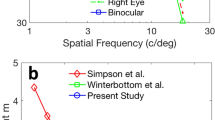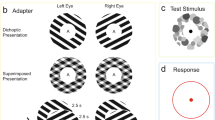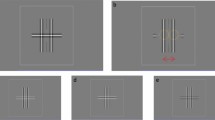Abstract
IN the human visual system, pathways from the two eyes converge anatomically by partial crossing over of the optic nerve fibres at the optic chiasma. Neurophysiological studies of the primary visual cortex of primates have established that these converging pathways carry signals from both eyes to the same cortical neurones1. In normal viewing conditions, each eye forms an image of the external visual field, the point of attention in the field being centrally fixated in both eyes. There is a small difference in the relative positions of non-central image points formed on the two retinae because the eyes view the visual field from slightly different positions. The ability of the primate visual system to extract information about the depth of a focused object in the visual field apparently rests on the convergence on to single cortical neurones of signals arising from the slightly displaced images in the two eyes2. If each eye perceives a totally different visual stimulus, however, the visual signals arising from the two stimuli are perceptually antagonistic and, in this situation, an observer usually detects only one stimulus at a time. This phenomenon is referred to as binocular rivalry. We have investigated interactions between visual signals produced by two different stimuli when presented one to each eye.
This is a preview of subscription content, access via your institution
Access options
Subscribe to this journal
Receive 51 print issues and online access
$199.00 per year
only $3.90 per issue
Buy this article
- Purchase on Springer Link
- Instant access to full article PDF
Prices may be subject to local taxes which are calculated during checkout
Similar content being viewed by others
References
Hubel, D. H., and Wiesel, T. N., J. Physiol., Lond., 195, 215–243 (1968).
Hubel, D. H., and Wiesel, T. N., Nature, 225, 41–42 (1970).
Gilinsky, A. S., J. opt. Soc. Am., 58, 13–18 (1968).
Pantle, A., and Sekuler, R., Science, 162, 1146–1148 (1968).
Blakemore, C., and Campbell, F. W., J. Physiol., Lond., 203, 237–260 (1969).
Maudarbocus, A. Y., and Ruddock, K. H., Vision Res., 13, 1713–1737 (1973).
Burton, G. J., Vision Res., 13, 1211–1226 (1973).
Barlow, H. B., Blakemore, C., and Pettigrew, J. D., J. Physiol, Lond., 193, 327–342 (1967).
Blakemore, C., Vision Res., 10, 1181–1199 (1970).
Tyler, C. W., Science, 181, 276–278 (1973).
Blake, R., and Fox, R., Nature, 249, 488–490 (1974).
Author information
Authors and Affiliations
Rights and permissions
About this article
Cite this article
RUDDOCK, K., WIGLEY, E. Inhibitory binocular interaction in human vision and a possible mechanism subserving stereoscopic fusion. Nature 260, 604–606 (1976). https://doi.org/10.1038/260604b0
Received:
Accepted:
Issue Date:
DOI: https://doi.org/10.1038/260604b0
This article is cited by
-
Non-fusable stimuli and the role of binocular inhibition in normal and pathologic vision, especially strabismus
Documenta Ophthalmologica (1983)
-
Spatial characteristics of movement detection mechanisms in human vision
Biological Cybernetics (1980)
-
Properties of length-selective and non-length-selective adaptation mechanisms in human vision
Biological Cybernetics (1978)
Comments
By submitting a comment you agree to abide by our Terms and Community Guidelines. If you find something abusive or that does not comply with our terms or guidelines please flag it as inappropriate.



